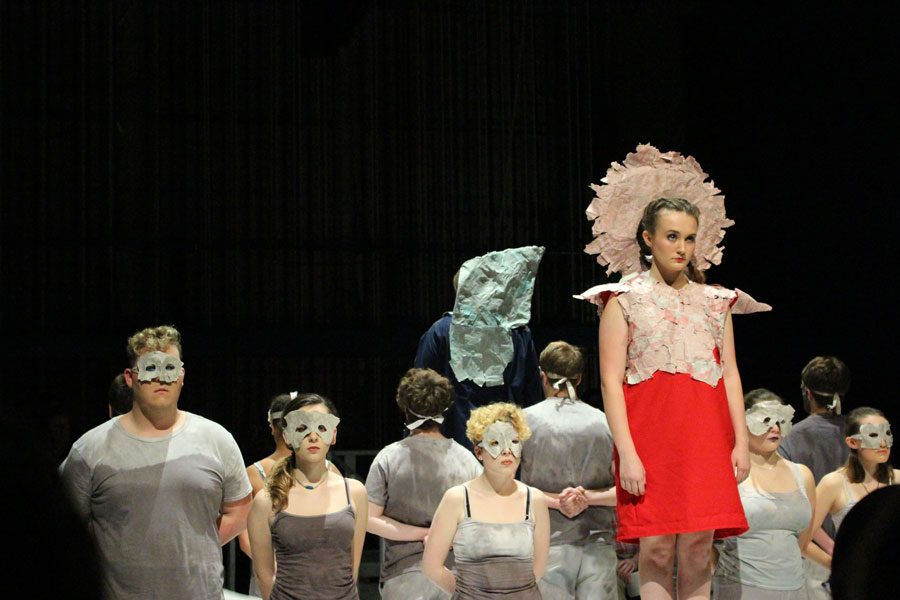Reimagining of “Antigone” brings political commentary to Dibden stage
On the stage of Dibden Center of Performing Arts sat Lucas Sirois and Katelyn Shaw in the skin of Creon and Antigone, respectively. Audience members quietly filled in the surrounding stage seats as the two actors glared across at each other. Bathed in dramatic lighting, the shadows that crossed Sirois and Shaw’s faces further conveyed the contempt the two characters had for each other. Ominous, if not slightly sad, music hung in the air. This was the first glimpse of JSC Theater’s “Antigone: Red Feed Blue Feed.”
The adaptation consisted of excerpts from Sophocles’ original “Antigone,” Bertold Brecth’s version and Jean Anouilh’s version, and original scenes from JSC freshmen Caleb Eugley and Shaun Bennet.
“Antigone: Red Feed Blue Feed” had all the same characters and basic storyline of the original story, but with some current political twists. The changes in the story stemmed from director Isaac Eddy’s vision of portraying the divide of our country due to what information reaches us, red feed or blue feed. This came across in a myriad of ways, from the costumes to the voting at the end done with red or blue “Facebook likes.”
The costumes donned by Antigone and Creon were red and blue, cementing their respective sides of the story. Added to Antigone’s red dress were shoulder guards and a halo seemingly made from cardboard. Creon’s blue suit was riddled with tape patches and had a cardboard accessory that resembled a shark’s fin. The ensemble was dressed in all gray with dark eyes and lips. Everyone looked like they were part of an avant-garde fashion show.
The set was merely a blank canvas for the actors to perform on. A rather small, white rectanglular platform separated the show from the audience, and the only objects on it were two white cubes used as seats, tables and platforms depending on the scene. The small performance space looked crowded when the entire cast was on it, and I noticed that sometimes actors narrowly missed collisions with audience members.
I had a few issues with the arena seating. At times it was hard to understand what was going on, especially when the actors faced away from where I was seated. However, that may have been an intentional part of Eddy’s vision to show that we never truly get the whole story. The close proximity of the audience to the actors did allow me to see the raw emotion in their faces when they were turned to my direction.
There were also a few times throughout the show where I became confused, which could have been entirely my fault. It’s possible that I zoned out and missed crucial points, but there were bits and pieces of the script where I simply had no idea what the characters were talking about. I have read Sophocles’ original story, so I thought I had a good understanding of the plot points. Perhaps the new additions to the adaptation clashed with what I expected was going to happen and threw me off guard.
While it takes an entire cast and crew to put on a production, it was Sirois and Shaw’s acting that really held my attention. They yelled, cried, fought and struggled in a way that commanded the audience’s attention. In the 90-minute runtime of the show, both actors portrayed their characters as three-dimensional, rather than all good or all bad.
Antigone sometimes came across as purely self-righteous, such as when her sister, Ismene, told Creon if he killed Antigone he would have to kill her too. Antigone became angry and said, “Don’t think you can just muscle in and die with me now!” It seemed like she wanted to be the only one with the glory of dying for a cause.
Creon, though very demanding throughout the show, did soften at times and portrayed a leader simply trying to keep everything together. He gave Antigone numerous chances to go home after she was caught burying her brother’s body. He tried to reason with her, but ultimately made his decision to keep order within his state.
Neither was the hero or the villain, it was all up for interpretation.
Right before the end of the play, Sirois and Shaw broke character to plead their case to half of the audience. Afterwards, the audience voted with red and blue pieces of paper decorated as Facebook likes on which ending they want, pro-Creon or pro-Antigone.
While I liked the direct address of the audience, I feel like it would have been more powerful and effective had the actors stayed in character. However, each actor only speaking to half of the room perfectly encapsulated Eddy’s vision of portraying the national divide.
“Antigone: Red Feed Blue Feed” came across as more of a progressive modern art piece than entertainment. In spite of the ups and downs, the ambitious performance proved to be a pleasant enough experience.






